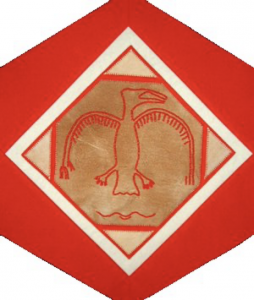Thompson

The Block
For centuries the Stein Valley, in the southern interior of British Columbia, has been the reliquary of ancient rock paintings depicting the dreams and visions of past generations of people. This block features a beaded replica of one of these pictographs, The Nicola eagle, which represents strength, and carries the prayers of the people to the Great Spirit. The Nicola eagle was commonly used as a motif for decorating articles of clothing; clothing that for the Nlaka’pamux people artistically expressed their deep love for the land. The piece was created by Sharon Dick, of the Lower Nicola Band, who taught herself beadwork after viewing a beautiful example of the craft.
Cultural Profile
The languages of the Nlaka’pamux all belong to the Salishan linguistic family. Traditional Thompson territory in the south-western part of British Columbia is a natural wonder. Within the area there are eleven different bio-geoclimatic zones and four eco-provinces, which include very sensitive ecosystems. The landscape ranges from deep river valleys and rolling highlands to plateaux and mountains, resulting in several climates––from desert-like to very wet––and a diverse wildlife population. Three-hundred of British Columbia’s 500 bird species can be found in this region.
The Thompson region is also rich in First Nations cultural history. The Stein Valley Nlaka’pamux Heritage Park has been home to the Nlaka’pamux for thousands of years. The word “Stein” is derived from the Nlaka’pamux word Stagyn, meaning “hidden place”, and indeed, from the mouth of the Stein River, the valley itself is barely noticeable. The area contains many rock pictographs painted on the canyon walls by their ancestors. Further evidence of the ancestors is provided by the deep, round impressions located in the ground along rivers and lakes; signs of Nlaka’pamux winter and summer homes and food caches of long ago.
Asking Rock, near Stryen Creek, is an particularly spiritual site for Nlaka’pamux people. The peaceful surroundings provide an ideal place to make prayer offerings of aromatic burnt sage and tobacco. Hikers traversing the area must not touch the pictographs, which are part of the Nlaka’pamux’s cultural heritage, and must respect the natural environment.
The Nlaka’pamux are well-known for their expertise in weaving. When deer hunting produced little results and no buckskin was available, the people would put their weaving skills to work using the bark and inner fibres of hemp, willow, cedar and sagebrush to make clothing. The depictions on the clothing communicated the wearer’s position in society, their relationships within the tribe and their place in the universe. The arrival of white traders and settlers during the early 1800s brought changes in fashion and decoration, but the skills involved in making traditional clothing were not lost.
Sponsor: Nicola Tribal Association
